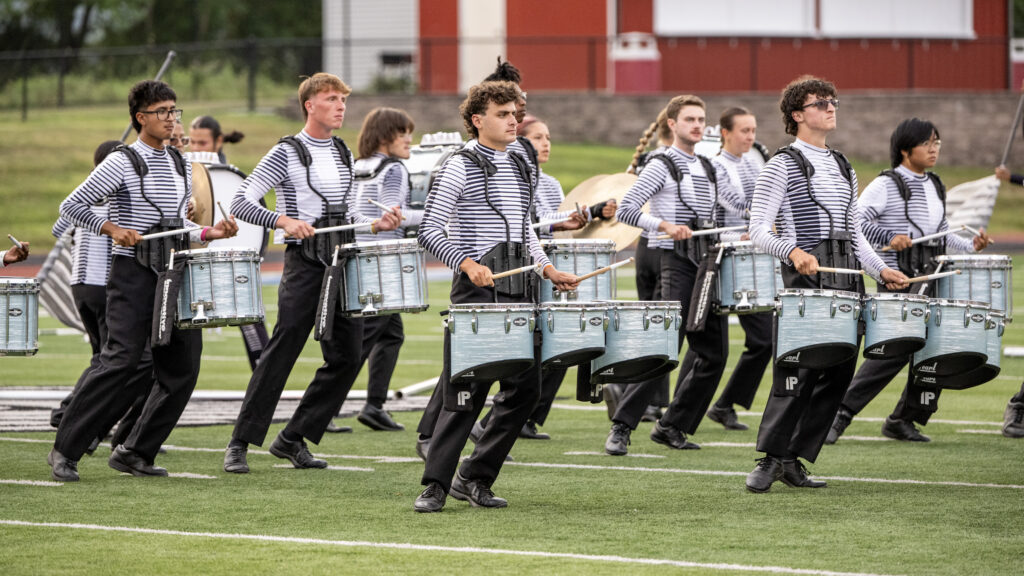The 2008 Drum Corps International World Championships went to Indiana University’s Memorial Stadium in Bloomington after news broke that the new Lucas Oil Stadium in Indianapolis wouldn’t be finished in time to host the event.
While there was a lot of excitement at the top of World Class ranks, there was also plenty of competitive intrigue among the corps hoping to earn a spot among the top-12 finalists. Perhaps the most grateful corps to make the Finals was the 12th-place Madison Scouts, who earlier that season had lost to the Crossmen, Colts, Spirit and Troopers, four corps that didn’t make the top-12 cut come August.
Crossmen finished in 13th, just 0.425 points from advancing into the Finals for the first time since 2004. Behind the 14th place Colts was 15th place Spirit, two years before the corps reverted to its original name of Spirit of Atlanta. Spirit had succeeded to place among the top-12 corps in each of the previous three seasons.
Spirit’s 2008 show was titled, “pe-ri-4-ry,” based on the word, “periphery,” defined as the area that surrounds a place or thing. The unique spelling of the show’s title referenced the playful, ongoing homage to the numeral four. Drill formations, color guard choreography, and groupings of corps members often adhered to the number, and music was often layered in instrumental groupings of four. Throughout the show, music demonstrated a recurring minimalist pointillism that contributed to an evocative sense of haunting.
The opener was “Equus,” written for wind ensemble between 1997 and 2000 by American composer Eric Whitacre. The pulsating rhythmic vigor of “Equus” created a sense of perpetual motion that Whitacre referred to as “dynamic minimalism.” He expressed a joy in the use of repetitive patterns, “as long as they don’t get boring.” The term “equus” is Latin for “horse,” and indeed, if audience members let their imaginations flow, they can visualize a horse galloping through the piece.
Four golden flags spun by Spirit members dressed in red (the rest of the color guard was dressed in blue) started the show by spreading out from the middle of the horn line in the center of the field. The brass players were set up in the formation of a large open box, a visual theme seen throughout the show. The drums were featured for most of the show’s first minute, with horns entering while playing backfield and coalescing into a rotating block diamond while turning to the front for the first big hit.

As a reminder of the theme, four “V” forms of horns came together in the center of the field, surrounded by four lines of flags forming a box. The center of each line of flags moved inward as if caused by the gravitational pull of the horns. The brass players then switched places with the flags and became the periphery box, surrounding the flags.
The second segment of “Equus” reflected the first one, but with more grandeur. Loud percussion intrusions poked through the musical fabric before totally taking control of the piece. The main theme from the show’s opening came back for a reprise, leading into a company front and a final defiant pose that brought the six-minute production to a close.
Famed film composers Hans Zimmer and James Newton Howard collaborated on the film score to “Batman Begins.” The 2005 superhero flick restarted the prolific Batman film franchise that had lain dormant since “Batman and Robin” in 1997. Each of the musical selections in “Batman Begins” was given the Latin name for a specific genus of bat.

The lovely “Corynorhinus” came from the start of the final section of the movie and is also the film’s main love theme. The piece was named for the genus of bats that exists only in North America. Utilized by Spirit as a ballad, the dark and brooding theme allowed for expressive body movements from the color guard sabers up front, ending with the four red-uniformed members of the guard surrounded by four rectangular blocks of horns.
The spooky “Myotis” came from early in the film and portrayed the ominous choices to be made by the Bruce Wayne character. Tubas introduced the angular melody and provided the oomph for most of the piece. The brass section was often featured in four sets of open and closed blocks. This led into a company front push to Michael Nyman’s “Piano Concerto” of 1994, based on the composer’s score to the 1993 film, “The Piano,” with “Equus” sneaking in to add a rhythmic pulse.
The horns formed another open box rectangle as “Equus” made yet another appearance, then collapsed into a diagonal block rectangle. Drums swept in to turn the form into a large numeral four, the cymbals completing the right side of the numeral’s arm. The show ended as the four guard members in red ran in from the sides to highlight the points of the “4.”
This week you can save on the World Championship DVD that contains this complete Spirit performance.
Buy the 2008 DCI World Championship Volume II DVD.
(Available this week only for 20% off.)
Discount DVD offer ends Monday, May 16, 2016.

Michael Boo was a member of the Cavaliers from 1975-1977. He has written about the drum corps activity for more than 35 years and serves as a staff writer for various Drum Corps International projects. Boo has written for numerous other publications and has published an honors-winning book on the history of figure skating. As an accomplished composer, Boo holds a bachelor's degree in music education and a master's degree in music theory and composition. He resides in Chesterton, Indiana.





